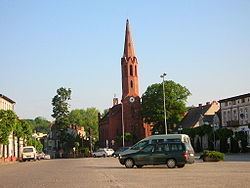Country Poland Gmina Wyrzysk Town rights fifteenth century Population 5,234 (2006) | Established fourteenth century Elevation 90 m (300 ft) Local time Thursday 7:00 PM | |
 | ||
Weather 9°C, Wind NW at 14 km/h, 50% Humidity Voivodeship | ||
Wyrzysk [ˈvɨʐɨsk] (German: Wirsitz) is a town in Poland with 5,263 (2004) inhabitants, situated in Piła County, Greater Poland Voivodeship.
Contents
- Map of Wyrzysk Poland
- Geographic location of municipal rural community of Wyrzysk
- History
- Famous people
- References
Map of Wyrzysk, Poland
Geographic location of municipal-rural community of Wyrzysk
Gmina (commune) Wyrzysk has a population of about 14,500 and occupies an area of 160.7 km². It lies on the northern edge of Greater Poland Voivodeship; in the east it borders gmina Sadki in the Kuyavian-Pomeranian Voivodeship. Of the district area, 117.11 km² are occupied by arable land and 19.65 km² by forests.
The commune used to be cut through by national road No. 10 leading from Szczecin to Warsaw but a bypass has now been built. This bypass connects Wyrzysk with Piła (37 km) and Bydgoszcz (55 km). The railway station in Osiek nad Notecią also provides a railway connection with Piła (39 km) and Bydgoszcz (48 km).
The commune lies in Krajna Plateau. Its southern border is formed by the River Noteć with its tributary, the Łobżonka, which cuts through the picturesque moraine hills rising over the wide valley of the Noteć. One of these hills, Dębowa Góra, reaches a height of 192 metres above sea level and is the highest elevation of the Krajna Region. Over 60 per cent of the commune is protected as an area of scenic beauty.
Conditions favourable for human settlement occurred in the present Wyrzysk Region in the postglacial period. Its relics are now left on the moraine hills along the Noteć River. Archaeological excavations in the village of Żuławka revealed that humans arrived here as early as nine thousand years ago. Soon they built a permanent crossing over the Noteć. Those wooden bridges in the vicinity of present Żuławka were maintained by people settling in this area for the following 3,500 years, which is a unique example of engineering skills in prehistoric Europe.
History
The Wyrzysk area was established first by East Germanic settlement at the beginning of the first millennium A.D. In the Middle Ages the Noteć became a natural border between the regions of Greater Poland and Pomerania, which long resisted the expansion of the German margraves, Polish Piast dynasty, and since the 13th century also the Teutonic Knights. With time, local people adopted the Slavic name Krajna for the area to the north of the Noteć. Finally the Polish King Bolesław the Wrymouth (1106–1138) conquered the castles on the Noteć and incorporated Krajna into Kingdom of Poland for the next 700 years.
The first preserved mention of Wyrzysk dates back to 1326; the name of the place was then recorded in the so-called Greater Poland Codex. Wyrzysk was probably granted the royal charter before 1450; in 1565 it became a town under the so-called Magdeburg law. As a result of series of wars in the second half of 17th century and beginning of 18th Wyrzysk became in fact a village. Wyrzysk was annexed by Prussia in 1772 following the first Partition of Poland. The city rights were renewed in 1773 by the Prussian King Frederick the Great who made the town a centre administering the construction of the Bydgoszcz Canal and the regulation of the Noteć. From 1807 to 1815 the town was a part of Napoleon's Duchy of Warsaw and subsequently it was given back to Prussia as a result of Congress of Vienna. It remained Prussian until the end of First World War.
In 1772, after the first partition of Poland, Krajna became part of Kingdom of Prussia. The Prussian monarch and his successors aimed at Germanisation of the annexed lands. The methods included the ban on Polish language, introduction of Prussian administration and German language and education, encouraging and supporting Prussian settlement while discouraging any further Polish settlement in the area, as well as purchasing estates from the Polish gentry. Wyrzysk and some surrounding areas was sold by Karol Rydzyński, Roch Sypniewski i Maria Samostrzelecki to King Frederick II The Great himself in 1773. In 1807–1815 the Wyrzysk area belonged to the Napoleon's Duchy of Warsaw, but in 1815 was retaken by Prussia. In 1818 Wyrzysk became the seat of a county in the Grand Duchy of Poznań. After years of Germanisation, when the area became increasingly populated by Germans, the Prussians abolished the law of corvée at the beginning of the 19th century. The resistance to Prussian rule accelerated the economic development and progress, especially in agriculture. Conflicts arose especially during the Kulturkampf period. The pressure of Germanisation and flood of German settlers encountered growing resistance from the discriminated Polish population of Krajna, who clung to their native language and the Roman Catholic religion. This found expression among decreasing Polish population in the establishment of patriotic Polish associations, choirs, sports clubs, banks and self-help organizations.
Wyrzysk was incorporated into a newly reborn Poland in 1919 by Treaty of Versailles, but merely 20 years later, with the beginning of World War II, the city was yet again occupied by Germany and made part of the new Third Reich province of Reichsgau Danzig-West Prussia as the seat of the county/district (kreis) of Wirsitz. The town was taken by Red Army in January 1945 and returned to Poland after the war.
